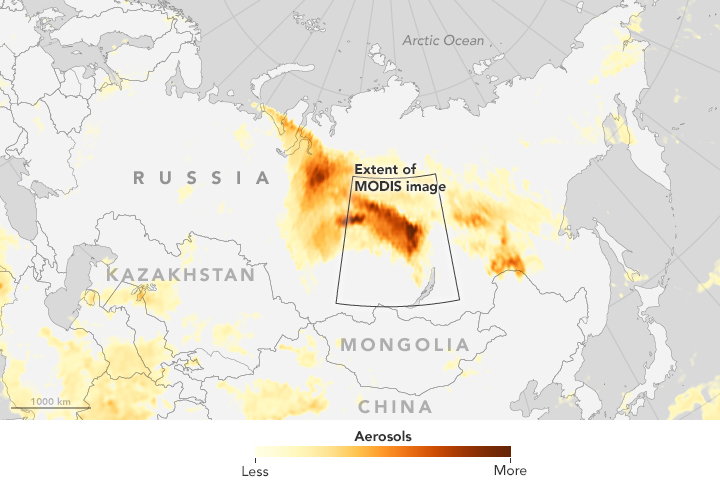


In mid-September 2016, wildfires continued to burn in Siberia amid what has been an active fire season for the region.
The natural-color image above, acquired on September 18, 2016, by the Moderate Resolution Imaging Spectroradiometer (MODIS) on NASA’s Aqua satellite, shows huge plumes of smoke streaming toward the northwest. Areas in red show where MODIS detected unusually warm temperatures associated with fire.
The map (second image) shows the concentration of aerosols over Russia on September 18 as detected by the Ozone Mapping Profiler Suite (OMPS) on the Suomi-NPP satellite. High concentrations are represented with shades of deep red; the lowest concentrations are shades of light yellow.
Other data revealed that smoke from the fires was lofted high into the atmosphere. On September 20, the Cloud-Aerosol Lidar and Infrared Pathfinder Satellite Observations (CALIPSO) satellite, which can detect the altitude of ash clouds, indicated that the tops of the smoke plumes reached an altitude of 9 kilometers (30,000 feet).
An image of the same region acquired a few days earlier shows the smoke moving toward the southwest near the town of Ust’-Kut, Russia. A smoky haze filled the sky, and flakes of ash from the fire fell over the town, according to a local news report. The report also noted that employees of the Eastern Siberia-Pacific Ocean oil pipeline (which passes through the area) had to be evacuated.
These fires are the latest in an active fire season. In late June 2016, satellites showed wildfires between the Russian cities of Miryuga and Koyumba, roughly 100 miles (160 kilometers) east of the current flames.
NASA image by Jeff Schmaltz, LANCE/EOSDIS Rapid Response. Caption by Kathryn Hansen and Pola Lem.